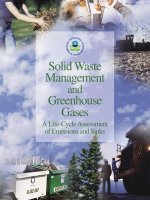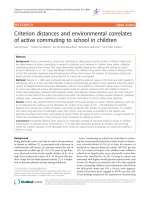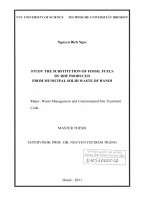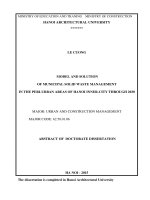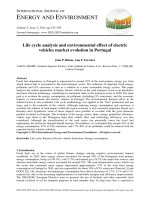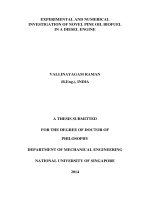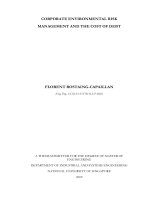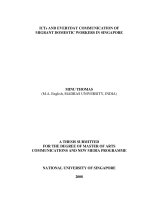Solid waste management and environmental compliance of historic hot spring resorts in calamba city laguna, philippines
Bạn đang xem bản rút gọn của tài liệu. Xem và tải ngay bản đầy đủ của tài liệu tại đây (1.19 MB, 66 trang )
THAI NGUYEN UNIVERSITY
UNIVERSITY OF AGRICULTURE AND FORESTRY
MARK VIXEN V. GLODO
SOLID WASTE MANAGEMENT AND ENVIRONMENTAL
COMPLIANCE OF HISTORIC HOT SPRING RESORTS
IN CALAMBA CITY, LAGUNA, PHILIPPINES
BACHELOR THESIS
Study Mode:
Full-time
Major:
Environmental Science and Management
Faculty:
Advanced Education Program
Batch:
2015 – 2018
Thai Nguyen, 25/09/2018
DOCUMENTATION PAGE WITH ABSTRACT
Thai Nguyen University of Agriculture and Forestry
Degree Program
Bachelor of Environmental Science and Management
Student Name
Mark Vixen V. Glodo
Student I.D
DTN1454290111
Thesis Title
Solid Waste Management and Environmental Compliance of Historic
Hot Spring Resorts in Calamba City Laguna, Philippines
Supervisor (s)
Dr. Maricris G. Unico
Mrs. Ly Thi Thuy Duong
Supervisor (s)
Signature
Abstract:
Pollution is one of the world’s worst problems and became an issue from the past
decades until now. Generations of waste are rapidly increasing due to some reasons like
tourism, population growth, and building infrastructure, migration from rural-urban. Most
of the people concern about this is solid waste management. Calamba City also known as
resort capital of the Philippines because of its hot spring resorts. With the rapid
constructions of resorts in Calamba City it also increases the generation of waste. The study
will determine the solid waste management practices and environmental compliance of the
selected hot spring resorts in Calamba City. It will also assess the current solid waste status
of the hot spring resorts in terms of waste generation, waste disposal, waste collection and
waste handling and sorting. The study will also assess the extent of environmental
compliance of the historic hot spring resorts. The study aims to increase the knowledge of
people in solid waste management to help the community and environment to decrease the
level of pollution. With the help of proper solid waste management practices and
environmental ordinances by the local government, it will decrease the generation of solid
waste in one area meaning it will also decrease the health risk and disaster in the
community.
Keywords
Solid Waste Management, Environmental Compliance, Waste
Generation, Waste Handling and Sorting, Waste Collection, Waste
Disposal
ii
Number of Pages
Date of
submission
September 25, 2018
iii
ACKNOWLEDGEMENT
The researcher wants to express his utmost gratitude and deepest appreciation to his
wonderful, loving, and supportive family Rodolfo M. Glodo Jr., Teresita Aya Ay Villarica,
Everett Lloyd V. Glodo who keeps on supporting him through his ups and down moments.
Thank you for the unending love, and prayers. To his cousins for giving him all the supports.
To the two beautiful and understanding thesis advisors Mrs Ly Thi Thuy Duong of Thai
Nguyen University of Agriculture and Forestry for giving giving ideas and assistance as the
author conducted her research study and deepest appreciation to Dr. Marcris G. Unico of
Laguna College of Business and Arts for giving me lots of words of wisdom that became his
inspiration as the author conducted his research study.
Sincerest thank you to all respondents who invest a little time answering the structured
questionnaire and interview specially the owners of the resorts for letting the researcher
conduct a survey in their facilities for his research study.
To Advance Education Program, Thai Nguyen University of Agriculture and Forestry
together with the staffs for giving him opportunity to study abroad.
To the batch K46-AEP, for sharing beautiful memories, knowledge and food along his
journey in Vietnam.
To all friends especially Anne Gillyn Raymundo, Camhil Lacap, Manuel Victor Ramirez,
Saintly Ghia Sarmiento Jeanne Corpuz, Nicole De Castro, Hannah Ayson, and Jefferson
Vivas.
The author got this far because of you all, w`ho pushed him to pursue his goals, who
relieved his stresses, who enlightens his mood, who gives his positivity in life, and who keeps
on sending prayers for him. Words are not enough to express how thankful and blessed the
iv
author is. All the author can do is to take a new step with all the lessons, laughers and
memories you have shared with him. May the Lord bless all of you.
Mark Vixen V. Glodo
v
TABLE OF CONTENTS
ACKNOWLEDGEMENT .............................................................................................................. iv
TABLE OF CONTENTS ............................................................................................................... vi
LIST OF FIGURES ...................................................................................................................... viii
LIST OF TABLES.......................................................................................................................... ix
LIST OF ABBREVIATIONS.......................................................................................................... x
PART I. INTRODUCTION............................................................................................................. 1
1.1. Research Rationale ................................................................................................................... 1
1.2. Research’s Objectives ............................................................................................................... 4
1.3. Research Questions and Hypotheses ........................................................................................ 5
Hypotheses....................................................................................................................................... 6
1.4. Significance of the Study .......................................................................................................... 6
1.5. Scope and Limitation ................................................................................................................ 7
1.6. Definition of Terms .................................................................................................................. 8
1.7. Research Paradigm ................................................................................................................... 9
CHAPTER II: LITERETURE REVIEW ....................................................................................... 11
2.1. Solid Waste Management Practices ........................................................................................ 11
2.2. Environmental Compliance .................................................................................................... 13
2.3. Waste Generation.................................................................................................................... 14
2.4. Waste Collection ..................................................................................................................... 16
2.5. Waste Disposal ....................................................................................................................... 18
2.6. Waste Handling and Sorting ................................................................................................... 20
CHAPTER III: METHODOLOGY ............................................................................................... 23
3.1. Research Design ..................................................................................................................... 23
3.2. Population and Sampling ........................................................................................................ 23
3.3. Respondents of the Study ....................................................................................................... 24
3.4. Data-Gathering Procedure ...................................................................................................... 24
3.5. Validation of Instrument ......................................................................................................... 25
3.6. Ethical Considerations ............................................................................................................ 25
3.7. Treatment of Quantitative Data .............................................................................................. 26
CHAPTER IV. RESULTS AND DISCUSSION .......................................................................... 29
CHAPTER V: SUMMARY OF FINDINGS, CONCLUSIONS, AND RECOMMENDATIONS40
5.1. Summary of Findings ............................................................................................................. 40
5.2. Conclusions............................................................................................................................. 41
vi
5.3. Recommendations................................................................................................................... 42
REFERENCES .............................................................................................................................. 43
APPENDICES ............................................................................................................................... 50
vii
LIST OF FIGURES
Figure 1: The Research Paradigm .................................................................................... 10
viii
LIST OF TABLES
Table 1: Arbitrary Scale for the Solid Waste Management Practices ...................................... 27
Table 2: Arbitrary Scale for Extent of the Environmental Compliance ................................... 27
Table 3: The Status of the Solid Waste Management Practices of the Historic Hot Spring
Resorts in Calamba City, Laguna, Philippines in terms of Waste Generation......................... 29
Table 4: The status of the Solid Waste Management Practices of the Historic Hot Spring
Resorts in Calamba City, Laguna, Philippines in terms of Waste Handling and Sorting ........ 31
Table 5: The Status of the Solid Waste Management Practices of the Historic Hot Spring
Resorts in Calamba City, Laguna, Philippines in terms of Waste Collection .......................... 32
Table 6: The Status of the Solid Waste Management Practices of the Historic Hot Spring
Resorts in Calamba City, Laguna, Philippines in terms of Waste Disposal ............................ 33
Table 7: The Environmental Compliance of Historic Hot Spring Resorts .............................. 35
Table 8: Test of Significant Difference on the Assessment of the Resort 1 and Resort 2
Respondents on the Status of the Solid Waste Management Practices and the Environmental
Compliance of the Historic Hot Spring Resorts. ...................................................................... 37
Table 9: Regression Analysis on the Impact of Solid Waste Management Practices to the
Environmental Compliance ...................................................................................................... 38
ix
LIST OF ABBREVIATIONS
DENR
Department of Environment and Natural Resources
GDP
Gross Domestic Product
MRF
Material recovery facility
MMDA
Metro Manila Development Authority
SPSS
Statistical Package for Social Sciences
SWM
Solid Waste Management
UNEP
United Nations Environment Programme
x
PART I. INTRODUCTION
1.1. Research Rationale
One of the main problems that the world is facing right now is pollution.
Pollution has been a problem from the last centuries until now. One of the areas
of concerns in pollution issues is waste management. Such concern is now
becoming a major and global environmental issue. Waste is generated daily by
performing various human activities, social and economic.
Many factors can contribute to the accumulation of waste. Population
movements due to birth, migration and travel which include tourism as well as
economic development have greatly contributed to the rapid generation of solid
waste. By 2050, the world is expected to generate 3.40 billion tons of waste
annually, increasing drastically from todays 2.01 billion tons (Kaza et al., 2018).
In a sense, this equates to a comparable increase of solid waste within the coming
fifteen years amounting from 1.2 kilograms per individual to 1.42 kilograms, on
a day to day bases (Rajan et al., 2016).
Tourism as factor to solid waste management accumulation has been
observed in many places all around the globe. Since such is a common human
activity, countries all over the world benefitted and suffered from the effect of
tourism. The World Tourism Organization has estimated revenue of £950 billion
from this activity in 2014. While this means positive promotion and development
to those areas and countries that were often frequented by tourist; it likewise
entails issues on pollution and even energy consumption. The United Nations
Environment Programme (UNEP) stated that tourism contributed 4.8 million tons
1
of solid waste, globally. The increase on solid waste is seasonal and is often due
to unfamiliarity of the tourists with the various waste systems adopted by an area
and littering which is found out to have significant contribution to the tons of
plastic wastes that lead to the sea each year (McDowall, 2016).
Philippines, with its beautiful beach hubs and other tourist attractions, have a
thriving tourism industry attracting both local and foreign tourists. As of the
present, this industry contributed 8.6 % of the country’s GDP. It becomes a
major economic contributor when local governments started promoting local
tourists areas of their zones. Indeed, every locality wanted to have a slice of this
thriving industry to: 1) help citizens rise from their impoverished states; 2) it is a
potential investment; and 3) attract and justify developmental projects
(CNN.com, 2018).
Calamba City is known as the resort capital of the Philippines and it is one of
the most promising places in Laguna. Calamba is a 1st class city with 54
barangays. Its lands are majorly used for agricultural activities and residential
development but many industrial sites are also located in the area. It is also the
birth town of the country’s famed national hero Jose Protacio Rizal Mercado y
Alonzo Realonda. Adding to its tourist attraction its proximity to Manila – the
capital city of the country- is only 54 kilometers away from it, south bound. It is
noted that the city generates an income of Php 400 million or $8.6 million every
4 years (Baltazar & Seki, 2017).
Since
the
declaration
of
Calamba
as
the
“Regional
Center
of
CALABARZON”, investors and more tourists found a popular destination. One
2
of the considerations is the abundance of hot spring resorts in the area (Bavarian,
2015). Most of the hot spring resorts are located in two barangays of Calamba
City which are Brgy. Bucal and Brgy.Pansol. Due to the fact that both barangays
have natural water source such as springs, resort owners do not have any problem
regarding their water supply for the business. Lots of people are enjoying the hot
spring resorts because of its warm and relaxing water that are said to reduce
stress. Some old sayings claim that historic resorts in the area can cure some
illness or disease; hence, one can observed the number of people who have
recently underwent surgeries or recovered from heart attacks to soak in the warm
waters of Calamba City’s hot spring resorts.
Tourism, again, has its own negative impacts especially towards the
environment regardless of its positive contribution to the economy (McDowell,
2016). As such, it is necessary to understand and accept that socio-economic
activities are manifested in the generation of solid waste. Waste materials are
among the fastest spreading pollutants. Without the proper structure and program
of managing solid waste it could contribute to the decrease of available lands for
agriculture, residential and other economic developments; declining health of the
population; polluting the sea and other bodies of water; and later on, decreased in
economic progress.
No matter how natural waste generation is in all human activities, improper
solid waste management remains a concern of everyone. It is absolutely
considered to be a crucial utility mostly in urbanized and populated areas. Most
importantly, it is a human need and a human right. The absence of proper waste
3
regulation leads to throwing of solid waste in improper places that may have
direct and indirect effect to the population and of course- the environment San
Diego, 2007).
In general, solid waste management intends to avert the effect of solid waste
to human health (Reyes, 2013). This is reiterated in the work of San Diego
(2007) by stating that the ignored solid waste degrades the environment and leads
to diseases.
This study would investigate the solid waste management practices of
historic hot spring resorts in Calamba City and determine the environmental
compliance effort of resorts owners to environmental laws and ordinances of the
barangay and city. Likewise, the study aims to increasing the knowledge of
people towards waste management practices as a factor that may help the
environment and community to decrease the level of pollution.
1.2. Research’s Objectives
General Objective: Mainly, this study will look at the solid waste
management practices and environmental compliance of historic hot spring
resorts located in Barangay Pansol, Calamba City, Laguna, Philippines.
Specific Objectives:
To assess the status of Solid Waste Management practices of the historic
hot spring resorts in Barangay Pansol, Calamba City, Laguna, Philippines.
To determine the extent of environmental compliance of hot spring
resorts.
4
To determine if there is a significant difference in the assessment of the
respondents to the SWM practices and the extent of environmental
compliance of historic hot spring resorts.
To proposed inputs to further improve the present compliances practices
of hot spring resort.
1.3. Research Questions and Hypotheses
Main question: What are the existing solid waste management and
environmental compliance practices of historic hot spring resorts in Barangay
Pansol, Calamba City, Laguna, Philippines?
Specifically, it sought to answer the following questions:
1. What is the status of the Solid Waste Management practices of historic
hot spring resorts in terms of:
1.1 Waste generation;
1.2 Waste handling and sorting;
1.3 Waste collection; and
1.4 Waste disposal
2. What is the extent of environmental compliance of these historic hot
spring resorts?
3. Is there a significant difference in the assessment of the respondents on
the status of the SWM practices and extent of environmental
compliance of historic hot spring resorts in Barangay Pansol, Calamba
City, Laguna, Philippines?
5
4. Do the assessed status of SWM practices singly or in combination
significantly impact the extent of environmental compliance of historic
hot spring.
5. Based on the results of the study, what inputs may be proposed to
further enhance the present practices?
Hypotheses
1. There is no significant difference in the assessment of the respondents
on the status of the SWM practices and extent of environmental
compliance of historic hot spring resorts Barangay Pansol, Calamba
City, Laguna, Philippines.
2. The assessed status of SWM practices does not significantly impact
the extent of environmental compliance of historic hot spring resorts
in Barangay Pansol, Calamba City, Laguna, Philippines.
1.4. Significance of the Study
This study holds significance to various stakeholders and community
members in relevance to solid waste management and environmental
compliance. The researcher found this study beneficial to the following
stakeholders:
Local government: The local governing unit of the area would have
insight on the current status of the historic hot spring resorts in its area and would
have a basis to further improve the development and implementation of the
existing environmental ordinances for further socio-economic progress.
6
Residents: People living around Barangay Pansol would have an idea on
how the existing historic resorts in their barangay positively and negatively affect
their environment.
Resort owners: Resort owners will be provided with insights on the status
and level of their compliance in the environmental acts or laws of the barangay,
city and national government.
Researchers: This study may be used as future reference by other
researchers who intend to investigate or review issues relevant to this paper.
Tourists: Tourists, whether local or foreign, would have an idea of the
current solid waste management system or policy and environmental practices as
adopted by the resorts, barangay and the city.
1.5. Scope and Limitation
Scope
This study aims to investigate the current solid waste management status and
environmental compliance practices of the two historic hot spring resorts in
Calamba City namely Cuyab Hot Spring Resorts and Laguna Hot Springs. These
two resorts were chosen since they already have 60 and 69 years of business
establishment respectively.
7
Limitations
This study will only cover the historic hot spring resorts located in Barangay
Pansol, Calamba City, Laguna, Philippines. Moreover, it will only focus on the
solid waste management practices and environmental compliance of such resorts.
This study included the respondents from the selected hot spring resorts in Pansol
Calamba City, Laguna particularly Laguna Hot Spring, and Cuyab Hot Spring
Resort. Only two (2) resorts were included in the study since it was required to
have resorts with twenty (20) and above years of business establishment and that
other resorts refused to be interviewed. Moreover, the two (2) resorts interviewed
also refused to be photographed due to business confidentiality.
1.6. Definition of Terms
To guide the readers in the discussion and clarity of the terms used, the
conceptual and operational definitions of the terms are hereby presented:
Compliance - It refers to the act or process of doing what you have been
asked or ordered to do: the act or process of complying (Merriam-Webster’s,
1828).
Commercial waste – the waste coming from business sometimes it is also
waste from the costumers (e.g food wrappers and containers). (Y Mongtoun et
al., 2014).
Environmental Ordinances - Law to protect and maintain or improve the
current environmental status. (R. Martella Jr. & J. B. Grosko 2014).
8
Historic Hot Spring Resorts - These refers to the resorts that are considered
old in the business set-up and have been in existence for more than twenty (20)
years.
Solid waste - This refers to all discarded household, commercial, nonhazardous, institutional and industrial (J. G. San Diego 2015)
Solid Waste Management Practices - This refers to the systematic
administration of activities which provide for segregation at source, segregated
transportation, storage, transferring, processing, treatment, and disposal of solid
waste and all other waste management activities.
Waste Generation – Waste produced from residential, commercial,
institutional and industrial areas. (J. G. San Diego, 2015).
Waste sorting and handling – It refers to the core procedure that follows
after the separately collected packaging waste from municipal, commercial and
industrial waste collection has reached the recycling facilities (CEE Group).
Waste collection – This is the collection of solid waste from point of
production (residential, industrial commercial, institutional) to the point of
treatment or disposal (WB, 2015).
Waste disposal – The process of putting waste into a landfill for the purpose
of final burial, destruction or placement for future recovery (Y. Guangyu).
1.7. Research Paradigm
The research paradigm will serve as guide in the development of this
study. Independent and dependent variables would be considered to determine if
9
there is a relationship between the solid waste management and environmental
compliances practices of historic resorts in area of concern. The literature of
related topic will also be bases for the further validation and justification of this
paper and would be effectively used for sound comparisons of concepts, ideas
and theories this paper would work on.
Independent Variables
Dependent Variables
Solid Waste Management
Practices
-
Waste Generation
Waste sorting and
handling
Waste collection
Waste disposal
Environmental Compliance
Figure 1: The Research Paradigm
The figure above is composed of independent and dependent variables
considered in this paper. The box on the left contains the independent variables
which are the solid waste management practices. These variables become
independent as they will be implemented regardless of the existence of the other
box. The other box contains the dependent variable since the handling of this
variable would rely on the existing solid waste management practices of the
historic resorts as well as the available environmental practices in the area.
10
CHAPTER II: LITERETURE REVIEW
2.1. Solid Waste Management Practices
Calamba City has a total land area of 149.5 km2 which occupies 12.66% of
the whole Laguna province. Expansion in its population is attributed partly to inmigration. The Department of Tourism has recognized the key role of Calamba
City in promoting the tourism industry mainly because of two factors: 1) being
the hometown of the country’s national hero and 2) through its popular hot spring
resorts and spas recognizing it as the “Hot spring capital of the Philippines”.
Tourist coming from the capital city of the country as well as those from nearby
and further provinces visit this City to enjoy the historic hot spring resorts in the
place (Jago-on et al., 2017).
Businesses under the tourism industry must recognize that “solid waste
management is a critical aspect of their environmental management” (Pirani and
Arafat, 2014). Businesses should always remember that their operation does not
just rely on the generation of income. They must look at the possible effect of
their operation in the environment, in general, since there would always be a
corresponding effect. Hester et al (2002), as cited in the work of Pucino (2016)
stated that the ultimate by-product of the societies is the solid waste generated in
every aspect of individual and population growth. Contrary to what many
deemed, municipal waste management is merely a puny fraction of the total solid
waste. In terms of generation of solid waste, many factors influence waste
production including population and economic development. In Pucino’s study,
major resort hubs all over the world were mentioned and how much solid waste
11
built up tourism activities have contributed. In the long run, if wastes are not
properly managed, the economy would consequentially suffer.
As defined by Rajan (2016), solid wastes are those rubbishes or items that
are non-liquidated and no longer have any value to a person responsible for it or
owning it. It is both the organic and inorganic waste materials generated from the
various activities of the society. Pirani and Arafat’s study (2014) critic the
tourism-related businesses’ practices way back 1990s for being insensitive with
the environmental impact of their activities.
It was acknowledged that tourism created job and generated income for the
economy, but as repercussion, it also contributes to the massive generation of
solid waste as emphasized by Hevera (n.d.). Vasquez et al. (2015) showed how
some resort and restaurant owners in the area of Laguna manage their wastes.
Based on this research, generated wastes from tourism-related industry are in the
forms of metal, leftover food, paper, and plastic. In view of the foregoing IRR of
the RA 9003, segregation is observed and each solid waste classification are
provided with individual bins.
Orpia in 2016 has reviewed the solid waste management practices of areas
where resorts populate in the country and shared that generally resorts owners are
aware of the existing policies on solid waste management and hereby complies
with them. As a matter, those interviewed by Orpia claimed that certain factors
influence the manner they comply with the Solid Waste Management Policy of
the country such as schedule of waste collection, inaccessible dumpsites and
failure to collect garbage by those tasked by the government.
12
2.2. Environmental Compliance
Recently, the Philippine government shut down the operation of one of its
famous island and tourist destination- Boracay. The main reason being the
intention of salvaging the beauty of the island from the effect of its economic
activity. As part of this project, government agencies were tasked to review and
inspect the environmental compliances of those involved in tourism-related
businesses (abs-cbn.com). Primarily, Local Government Units, business owners,
local entrepreneurs are responsible for the strict implementation of policies on
sanitation code, such as RA9003 (Garcia, 2016).
Localized initiatives are developed and observed by both community-based
and private sectors. Mostly, these initiatives gained success in terms of creating
awareness. Through DENR and MMDA, sanitary landfills are being surveyed so
that generated and collected wastes will have areas for their dumping
(worldbank.com). Basically, waste segregation has been widely observed too but
collection and dumping of segregated wastes.
All industrial sectors in the Philippines are required to comply with the solid
waste management practices existing and implemented in the country. Whether a
business operates as part of the tourism industry or any other industry, the
government counts on it to strictly observed waste management implementation.
Solid waste management does not end in segregation alone or ensuring
awareness which have been religiously observed by historic resorts in Pansol.
Evaluation. Classification and proper waste disposal are likewise necessary.
13
Transforming wastes into resources through recycling is also another thing
(Gequinto, 2017).
2.3. Waste Generation
Waste generation and disposal is one of the environmental problem that have
a great impact to municipalities and government, generally in the worl. (Efe
2013). This study is supported by the study of Hoomweg and Bhada-Tata (2012)
yearly, world cities produces 1.3 billion tons of solid waste and expecting to
increase to 2.2 billion tons by 2025, which means the waste generation of the
lower income countries will be doubles over the next twenty years.
According to a report released by the World Bank (WB) cited in NG. J
(2012) study, from 29,315 municipalities waste generation in Manila, Philippines
will increase by 165 percent to 77,776 tons per day. Furthermore, according to
SEPO (2017) the increase of waste generation of the Philippines is because of
increase in population, improvement of living standards, rapid economic
growthm and industrilization especially in the urban areas. This is supported by
the report of World Bank (n.d) income level and urbanization are the factors in
increase of waste generation. As the living standard increase, consumption of
goods and sevices correspondinglt increases, as does the amount of waste
generated. On the other hand according to Abazeri (2014) stated that rural areas
tend to generate much lower quantities of waste due to lower income and
consumption levels and higher reusing and recycling rates. In the past few
decades, rapid urbanisation along with changes in consumption behaviour and
material have resulted in soaring levels of waste generated daily, making the
14
waste management systems in place inadequate to handle the overwhelming
quantity.
In the study of Oblak (2017) stated that on of the fastest growing industries is
tourism, with Europe contributing with half of international arrivals and abou the
same in income. The increasing number of tourism in the world means also the
increase of waste generated in a country. This means more tourists more waste,
and more waste inevitablu translate into a larger environmental footprint.
Similarly, one of the waste contributing factor in Europe is tourism
producing 6.7 percent of total waste generation that arises from the wider
services sector in the EU27. EEA (2010) cited in the study of Styles et al. (2013).
In every resorts there must be a proper waste management strategy specially
in the construction of the resorts, constructing a resort and any oter infrastracture
produce waste due to the materials that are already been used and ready for
disposal. Furthermore, resorts should implement a waste management system
that implies waste seggregation and minimisation of waste generation in their
facilities. Management should decide what are the things that can be brought in
their property that can lessen the production of waste. In addition, Waste should
be transported by the resort operator (or appointed waste service provider) from
the point of generation directly to the centralised waste storage area where it can
be safely stored prior to offsite disposal. For efficiency it is permissible to
establish intermediate storage areas/collection points; this would be at the
discretion of the resort management, and all such areas would have to comply
with safe storage requirements Minimisation the generation of waste is the first
15

